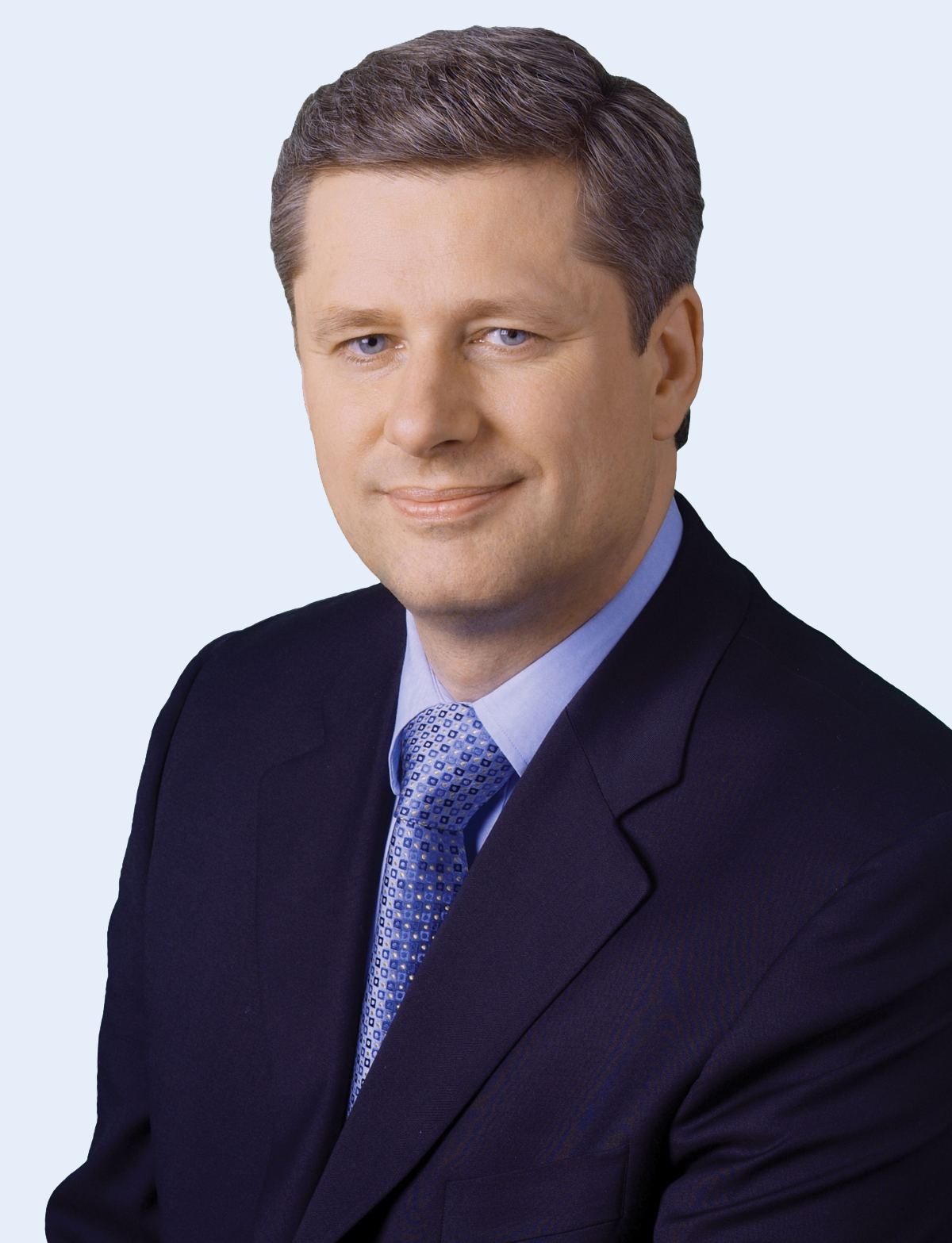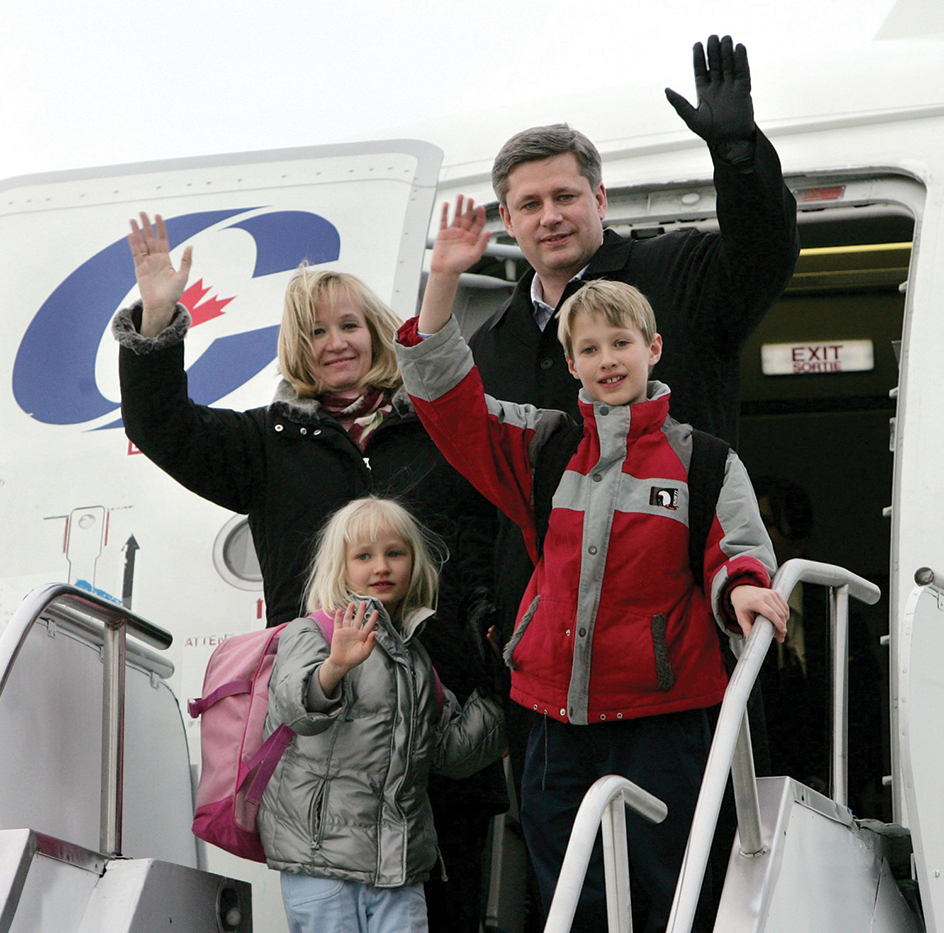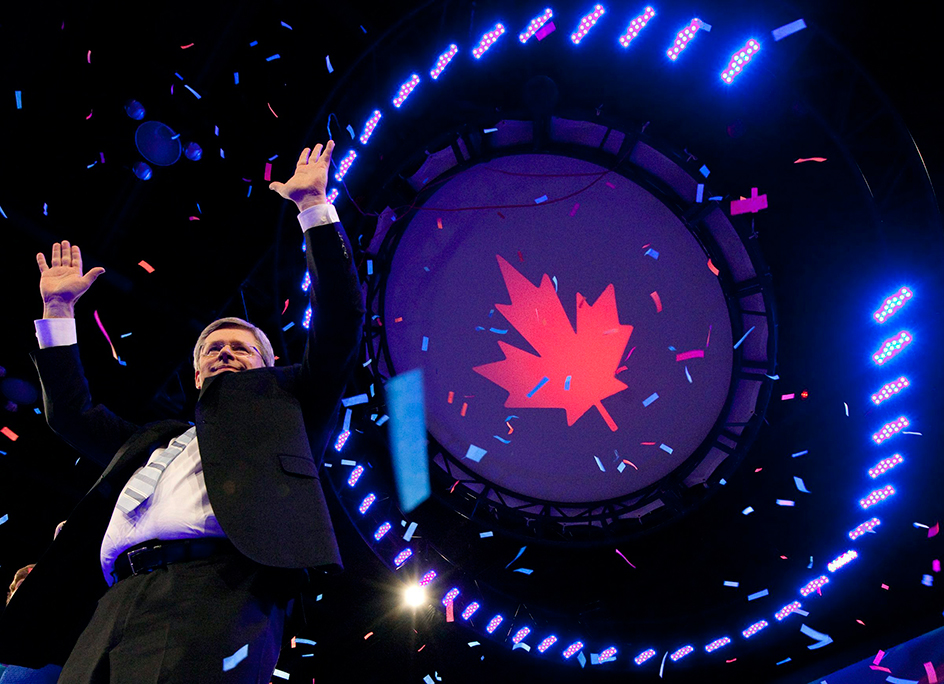Harper, Stephen Joseph (1959-…), served as prime minister of Canada from 2006 to 2015. He succeeded Prime Minister Paul Martin. Harper remained prime minister following general elections in 2008 and 2011. His Conservative Party of Canada lost a general election to the Liberal Party in 2015, and Justin Trudeau became prime minister. After the election, Harper resigned as Conservative Party leader, a position he had held since 2004.
Harper is trained as an economist. He has spent much of his adult life in politics and public service. Harper has favored a limited role for government, low taxes, free and open markets, traditional social values, and a strong national defense.
Like many Canadians, Harper enjoys ice hockey. He is a fan of the Calgary Flames and has a strong interest in hockey history.

Early life
Childhood.
Harper was born on April 30, 1959, in Toronto, Ontario. He was the first child of Margaret Johnston Harper, a homemaker, and Joseph Harper, an accountant for Imperial Oil Limited, a major petroleum company. The Harpers had two more sons, Robert and Grant, who both became accountants. Harper once joked that he went into economics because he lacked the sparkling personality to become an accountant like his father and brothers.
Stephen attended Richview Collegiate Institute, a public high school in the prosperous Toronto suburb of Etobicoke. He excelled academically, winning the school’s gold medal for graduating at the top of his class. Asthma prevented him from participating in most sports, but he joined the cross-country track team. He also belonged to the school’s Young Liberal Club.
Education and entry into politics.
After graduating from high school, Harper enrolled in the University of Toronto but soon left. In 1978, he moved to Alberta to work in the oil industry, and later in the computer industry. In 1981, Harper enrolled at the University of Calgary, where he earned a bachelor’s degree in economics in 1985. Harper’s politics grew more conservative, partly in response to Liberal Prime Minister Pierre Trudeau’s National Energy Program (NEP). Harper thought the NEP, introduced in 1980, involved an inappropriate degree of government intervention in the economy and harmed Alberta’s energy industry.
Political career
Early political activity.
While attending the University of Calgary, Harper became active in the Progressive Conservative Party of Canada. After graduation, he moved to Ottawa and worked for more than a year as a legislative assistant to Jim Hawkes, a Progressive Conservative member of Parliament. Harper returned to the University of Calgary in 1986 to pursue a master’s degree in economics. During this time, he remained politically active. He supported the adoption by the Progressive Conservatives of more conservative ideals.
Reform Party pioneer.
In 1987, Harper left the Progressive Conservatives to help found the conservative Reform Party of Canada. That same year, while still a graduate student, he was recruited by Preston Manning, the leader of the new party, to serve as a policy adviser. In 1988, Harper ran for Parliament as a Reform Party candidate from the riding (district) of Calgary West. He lost the election to Jim Hawkes, his former boss. Harper then gave up his graduate studies for a year and moved to Ottawa to become a legislative assistant and policy adviser to Deborah Grey, the Reform Party’s first member of Parliament.
In 1991, Harper received a master’s degree in economics from the University of Calgary. In 1993, he married Laureen Teskey, a graphic artist. The couple had a son, Benjamin, and a daughter, Rachel.

Member of Parliament.
Harper ran again for the House in 1993 as a Reform Party candidate from the Calgary West riding, again against Hawkes. This time, Harper won the election and served in Parliament until 1997. He resigned from Parliament in 1997 to become vice president of the National Citizens’ Coalition (NCC), a conservative lobbying group that promotes free enterprise and a limited role for government. From 1998 to 2001, he was president of the NCC.
In 2001, Harper and five other political and academic conservatives wrote a document titled The Alberta Agenda as an open letter to Alberta Premier Ralph Klein. The document, published in the Toronto newspaper the National Post, became famous as the “firewall letter.” It urged Alberta to erect a “firewall” around itself as a barrier against the federal government. Harper and his coauthors called for the province to collect its own taxes, establish its own pension plan and police force, and reject all federal intervention in provincial health care policy.
In 2000, the Reform Party renamed itself the Canadian Alliance, known formally as the Canadian Reform Conservative Alliance. The Alliance then became the official opposition in the House of Commons, a position the Reform Party had obtained after winning the second most seats in the 1997 election. Harper was elected Alliance party leader in March 2002. Later that year, he was reelected to the House in a by-election (special election to fill a vacant seat) from the Calgary Southwest riding. As Alliance leader, Harper became leader of the official opposition in the House.
In October 2003, Harper and Peter MacKay, then the leader of Canada’s Progressive Conservative Party, signed an agreement to merge their parties. With the support of party members, the Progressive Conservatives and Reformers united to form the Conservative Party of Canada. The new party became the official opposition in the House. Harper was elected as the first leader of the party on March 20, 2004.
Harper led the Conservatives in a parliamentary election in 2004. Liberals criticized him as a radical social conservative out of step with Canadian values. Paul Martin and the Liberals won a narrow victory in the election.
The 2006 election.
In November 2005, the opposition parties in the House passed a vote of no-confidence in Prime Minister Martin’s Liberal government. The vote followed an official report that the Liberal government of Jean Chrétien had misused public funds to benefit the Liberal Party and pro-Liberal advertising firms. Martin was forced to dissolve Parliament and call for a new parliamentary election to be held in January 2006.
During the election campaign, Harper and the Conservatives pledged to cut the goods and services tax (GST), a kind of sales tax, and to help parents of young children pay for child care. They also pledged to establish tougher sentences for gun crimes, introduce new laws to clean up government corruption, and implement a maximum wait time for health care services. In addition, Harper vowed to give provinces more power to manage their own affairs, support a proposal that Canada’s Senate be elected, rather than appointed by the governor general, and strengthen national defense.
Prime minister.
On Jan. 23, 2006, Harper led the Conservative Party to power in the election, ending 12 years of Liberal rule. The Conservatives won 124 of the 308 seats in the House of Commons. The Liberals won 103 seats, and the rest went to smaller parties and one independent candidate. The Conservatives had won the most seats in the House, but not a majority. They formed a minority government, which had to enlist the support of one or more other partiesto ensure passage of its planned legislation. Harper was sworn in as prime minister on Feb. 6, 2006.
Harper appointed a Cabinet with 27 members, much smaller than the 39-member Cabinet under Paul Martin. The new prime minister included six women in his Cabinet and one former Liberal, who had just defected from that party. To ensure regional representation in the federal cabinet, Harper chose 10 Cabinet ministers from the Western provinces, 9 from Ontario, 5 from Quebec, and 3 from the Atlantic provinces.
In September 2008, Harper requested that Canada’s governor general dissolve Parliament and call a general election. In the election, held October 14, the Conservatives again won the most seats in the House of Commons but fell short of a majority. Harper remained prime minister.
In December 2008, the Liberal and New Democratic parties formed a coalition, supported by the Bloc Québécois, to try to bring down the Conservative government in a no-confidence vote in the House of Commons. The opposition parties disapproved of a Conservative economic plan that they felt would not do enough to stimulate Canada’s economy. At Harper’s request, Governor General Michaëlle Jean suspended the work of Parliament until late January 2009, when the Conservatives unveiled a new budget. A majority of the members of Parliament approved the budget, which included such measures as tax cuts, spending on infrastructure (services and facilities), and worker training programs. As a result, the Conservatives remained in control of the government.
Harper again suspended Parliament from December 2009 to March 2010. Officials said that the government needed a break to focus on the economy. Some critics claimed the government was buying time in which to appoint new Conservative senators to Parliament. Critics also said that the government wanted to avoid an investigation about the torture of prisoners handed over to Afghanistan by Canada.
In March 2011, a legislative committee found the Harper government in contempt of Parliament—that is, wilfully disobedient to Parliament. The committee said the government had failed to provide accurate information about the cost of crime legislation and military equipment. It was the first time a Canadian government was found in contempt. The Conservatives lost the support of the House, and Harper adjourned Parliament. A general election was held in May, and the Conservatives won a majority of seats in the House. It was the first time Harper had led his party to a majority.
In August 2015, Harper asked Governor General David Johnston to dissolve Parliament in preparation for a general election on October 19. During the election campaign, polls indicated that the Conservatives, Liberals, and New Democrats were running a close race. The Liberals won the election with a majority, and party leader Justin Trudeau became prime minister. The Conservatives placed second and became the official opposition. Harper was elected to represent the riding of Calgary Heritage (formerly part of Calgary Southwest) in the House. He remained a member of Parliament but resigned as Conservative Party leader.
Later life.
In 2016, Harper resigned from the House of Commons. He then went on to establish the consulting firm Harper & Associates Consulting. In 2019, Harper was appointed as a Companion of the Order of Canada for his political career and his service as prime minister. Appointment to the order is one of Canada’s highest civilian honors.

